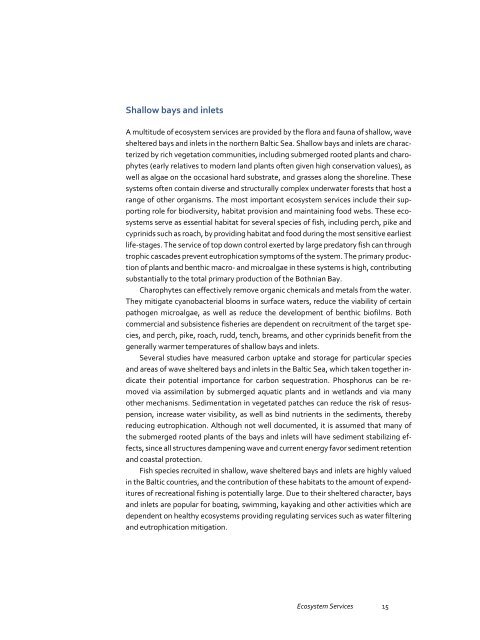Ecosystem Services
FULLTEXT01
FULLTEXT01
You also want an ePaper? Increase the reach of your titles
YUMPU automatically turns print PDFs into web optimized ePapers that Google loves.
Shallow bays and inlets<br />
A multitude of ecosystem services are provided by the flora and fauna of shallow, wave<br />
sheltered bays and inlets in the northern Baltic Sea. Shallow bays and inlets are characterized<br />
by rich vegetation communities, including submerged rooted plants and charophytes<br />
(early relatives to modern land plants often given high conservation values), as<br />
well as algae on the occasional hard substrate, and grasses along the shoreline. These<br />
systems often contain diverse and structurally complex underwater forests that host a<br />
range of other organisms. The most important ecosystem services include their supporting<br />
role for biodiversity, habitat provision and maintaining food webs. These ecosystems<br />
serve as essential habitat for several species of fish, including perch, pike and<br />
cyprinids such as roach, by providing habitat and food during the most sensitive earliest<br />
life-stages. The service of top down control exerted by large predatory fish can through<br />
trophic cascades prevent eutrophication symptoms of the system. The primary production<br />
of plants and benthic macro- and microalgae in these systems is high, contributing<br />
substantially to the total primary production of the Bothnian Bay.<br />
Charophytes can effectively remove organic chemicals and metals from the water.<br />
They mitigate cyanobacterial blooms in surface waters, reduce the viability of certain<br />
pathogen microalgae, as well as reduce the development of benthic biofilms. Both<br />
commercial and subsistence fisheries are dependent on recruitment of the target species,<br />
and perch, pike, roach, rudd, tench, breams, and other cyprinids benefit from the<br />
generally warmer temperatures of shallow bays and inlets.<br />
Several studies have measured carbon uptake and storage for particular species<br />
and areas of wave sheltered bays and inlets in the Baltic Sea, which taken together indicate<br />
their potential importance for carbon sequestration. Phosphorus can be removed<br />
via assimilation by submerged aquatic plants and in wetlands and via many<br />
other mechanisms. Sedimentation in vegetated patches can reduce the risk of resuspension,<br />
increase water visibility, as well as bind nutrients in the sediments, thereby<br />
reducing eutrophication. Although not well documented, it is assumed that many of<br />
the submerged rooted plants of the bays and inlets will have sediment stabilizing effects,<br />
since all structures dampening wave and current energy favor sediment retention<br />
and coastal protection.<br />
Fish species recruited in shallow, wave sheltered bays and inlets are highly valued<br />
in the Baltic countries, and the contribution of these habitats to the amount of expenditures<br />
of recreational fishing is potentially large. Due to their sheltered character, bays<br />
and inlets are popular for boating, swimming, kayaking and other activities which are<br />
dependent on healthy ecosystems providing regulating services such as water filtering<br />
and eutrophication mitigation.<br />
<strong>Ecosystem</strong> <strong>Services</strong> 15


